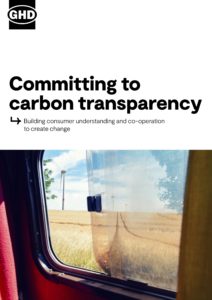 Professional services company, GHD is calling on the government to build on its 10-point plan to accelerate the UK’s path to net zero by introducing carbon labelling on consumer services. This would give consumers greater understanding of their carbon footprint so that they can make more environmentally friendly choices.
Professional services company, GHD is calling on the government to build on its 10-point plan to accelerate the UK’s path to net zero by introducing carbon labelling on consumer services. This would give consumers greater understanding of their carbon footprint so that they can make more environmentally friendly choices.
Four out of five UK consumers support the concept to ‘carbon label’ consumer services, such as a journey on public transport or an energy bill, according to a survey undertaken by GHD in October. The survey of 1,002 people into UK consumers’ understanding of the environmental impact of their daily habits also found that three out of five would pay more for environmentally friendly services.
GHD envisages that carbon labelling could work in a similar way to nutritional labelling by displaying the approximate carbon impact of a particular service on the ticket or bill, such as a journey on public transport or a month’s energy or water consumption. It could help companies offer carbon impact alternatives.
The survey indicates that greater transparency around the environmental impact of choices would help individuals to better understand their own carbon footprint, driving a conscious consumer shift in behaviours towards lower carbon consumption. If the UK is to achieve its 2050 net zero target, consumer behaviour could be the key agent of change which is yet to be fully recognised.
Perhaps unsurprisingly, the survey found that those of younger generations are more willing to adapt their lifestyles to help the environment. Significantly, despite typically earning less than their older counterparts, almost three quarters of the consumers polled aged between 18 and 24 would pay more for greener services.
Key observations from the research are as follows:
- 81% of British consumers support the concept of ‘carbon labelling’ on consumer services
- 60% willing to pay more for environmentally friendly services, with 40% willing to pay 5+% extra; 74% of consumers aged 18-24 would pay more
- 82% have at least some difficulty in understanding what their carbon footprint is
- 63% believe that, with greater transparency of their carbon footprint, they would shift towards lowering it; this is highest among those aged 18-24 (67%)
- 59% of consumers would choose lower carbon options if better informed about their overall consumption (70% of those aged 18-24)
- Only 24% of respondents believe businesses are transparent enough with consumers about their carbon footprint
Consumers would most like to see carbon labelling introduced on energy bills, water bills and travel tickets. Due to complex supply chains and reporting processes, this approach is best suited to industries where there is a clearer relationship between a product or service and its carbon impact, such as the water, public transport and energy sectors.
Commenting on the survey’s findings, David Maunder, technical leader – future energy at GHD, said, “The government’s 10-point plan is an important step in creating a decarbonised economy and contains key measures such as support to the development of hydrogen, carbon capture and investment into residential energy efficiency and electric vehicles. However, if the UK is to meet its target of net zero by 2050, not only will there be a need for new technologies and infrastructure, but consumer behaviour and choices will also play a central role in driving decarbonisation. The results of this survey lead us to believe that carbon labelling would be an extremely effective way of improving the general public’s understanding of their carbon footprint, while encouraging them to proactively participate in reducing their carbon consumption, and we urge the government to consider introducing this measure.
“There’s a clear appetite among the UK’s population to better understand and improve the impact of their carbon footprint, particularly among the 18-24 demographic. This demonstrates the heightened sense of environmental responsibility among younger generations, and we must support them now by providing the transparency and information needed to safeguard their future.
“Carbon labelling would afford the wider public more transparency on the environmental impact of their lifestyles and empower them to make better, greener choices. With consumers willing to act on this knowledge and pay more for services with a lower carbon footprint, in turn, companies will need to transform their operating practices in order to meet this demand. GHD aims to be at the front of this transition, supporting clients in their transition to achieve net zero.”
GHD’s full report on the findings of the survey, entitled “Committing to carbon transparency; Building consumer understanding and co-operation to create change”, can be found here.
Methodology
The survey was conducted among 1002 UK consumers, balanced by age, gender, and region. At an overall level, results are accurate to ± 3.1% at 95% confidence limits assuming a result of 50%. The interviews were conducted online by Sapio Research in October 2020 using an email invitation and an online survey.



